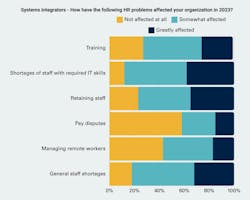This article originally appeared in the April 2024 issue of Security Business magazine. Don’t forget to mention Security Business magazine on LinkedIn and @SecBusinessMag on Twitter if you share it.
Trends such as cloud technology, hosted business models, Al, and IoT are disrupting the traditional system integrator role in many areas, including impacts to system design, installation, maintenance, upgrades, fulfillment, billing, and value creation.
This disruption has led to a challenging environment that is also filled with new opportunities for integrators, according to a new report from the Security Industry Association (SIA), The Evolving Security Industry and the Adaptation of the Systems Integrator.
Technology Evolution’s Effect
As research firms crunch the numbers, it is revealing a more rapid acceleration in the use of these once bleeding-edge technologies. Novaira Insights reports the number of professional cloud-connected video surveillance cameras installed in the Americas grew by 86% in 2023. Additionally, shipments of network cameras with embedded Al-capable chipsets grew by 66% in 2023.
Indeed, many of the fastest-growing security vendors are placing a greater focus on cloud and Al offerings, forcing many integrators to adapt them whether they want to or not.
“The security industry has historically taken a more conservative approach to embracing new technologies compared with other industries such as consumer electronics or automotive,” the report says. “However, some of the [technology adoption] trends – especially cloud and Al – are comparatively fast-paced as they utilize the bleeding edge of humanity's technological know-how. This is leading to disruption in some of the well-established sales channels and the route-to-market for security solutions. This is increasingly affecting security integrators, who are experiencing pressure to change.”
At the same time, the report says, the cybersecurity of physical security systems has become a greater concern than ever, with end-users increasingly requiring security systems integrators to ensure the cybersecurity of the systems they install and maintain.
68% of the system integrators surveyed for the report indicated that they expect to see increasing involvement from IT professionals in the procurement and/or use of physical security systems or their outputs in the next three years.
“Convergence between IT and security departments within organizations has caused security systems integrators to become more IT-focused,” it says. “68% of the system integrators surveyed for the report indicated that they expect to see increasing involvement from IT professionals in the procurement and/or use of physical security systems or their outputs in the next three years. Similarly, 54% of end-users indicated they expect to see this happen.”
An additional challenge the report points out is a shift in an integrator’s sales model.
“Traditionally, when security products left manufacturers or vendors, their partners would add services and value before these products were finally commissioned on behalf of a security end-user,” the report says. “Cloud is one of the major disruptors of the traditional approach. Once commissioned, cloud security systems have the potential to increase ongoing customer engagement from the systems integrator or installer post-sale, despite potentially less on-premises involvement. Direct-to-end-user sales of Software as a Service (SaaS) products mark challenges to the traditional security industry channel and risk bypassing some existing participants.”
The good news, the report says, is that these technology and sales disruptors can also offer opportunities to savvy integrators. The connectivity and scalability offered by cloud services will enable integrators to remotely integrate and offer a much wider range of tailored managed services, for example – all with recurring monthly or yearly revenue.
Greater connectivity and AI-powered intelligence provide an opportunity for integrators to be more proactive in maintenance and to leverage more advanced system lifecycle analysis. And due to the "stickier" nature of recurring contracts, there is an opportunity to leverage more business from existing accounts.
Access the full market research report from SIA (link at the end of this article) to learn more about these disruptive technologies, as well as strategies and opportunities as integrators transition to an RMR-based business model.
The Staffing Issue
Simply read the pages of this issue of Security Business (or any issue from the past few years), and you will get a sense of the urgent need for qualified technicians, sales staff, and even back-office help among security integrators. Thus, it is not a surprise that staff shortages, recruiting, retention, and training were hot topics among the integrators surveyed by SIA.
When asked their single biggest challenge, “the most common responses related to staffing challenges, such as hiring certified security professionals and hiring staff in general, retaining staff, training, and meeting wage demands,” the report says. In fact, 35% of systems integrators surveyed indicated that staffing challenges were their biggest single challenge.
Overall unemployment for technology workers is less than 2.5%; therefore, the security industry must compete with other industries for workers. The report says this is a long-term issue, and 30% of respondents cited staffing challenges as the biggest threat to their organization in the next five years.
Access the report (link at the end of this article) to read about how integrators can leverage career marketing, manufacturer programs, and other training to help entice more people to come to work in security.
Other Threats on the Horizon
Looking to the future, the report also asked integrators what they see as their biggest potential threats. Interestingly, security manufacturers themselves were cited as a threat.
“As vendors expand their portfolio of physical security cloud solutions (such as VSaaS, ACaaS and cloud-managed devices), there will be increasing opportunities for them to offer services [that may] overlap with those traditionally offered by systems integrators,” the report says. “Some vendors are already forging closer relationships with end-users and are able to sell them managed services provided via their cloud and not by the integrator. This can then lead end-users to connect with the vendor – not the integrator partner – when there are problems.”
Other threats cited include so-called Big Tech entrants to the industry, such as Google, Microsoft, Amazon, etc.; telcos packaging services with network access; IT integrators and MSPs, as well as AV integrators, getting into physical security; and enterprise end-users moving security services in-house.
This is just a small sampling of the variety of data available in SIA’s report. Visit www.securityindustry.org/report/the-evolving-security-industry-the-adaptation-of-the-systems-integrator to access it. It is free to all SIA members and is available for purchase for non-members.
Paul Rothman is Editor-in-Chief of Security Business magazine. Email him your comments and questions at [email protected]. Access the current issue, archives, and apply for a free subscription at www.securitybusinessmag.com.
About the Author
Paul Rothman
Editor-in-Chief/Security Business
Paul Rothman is Editor-in-Chief of Security Business magazine. Email him your comments and questions at [email protected]. Access the current issue, full archives and apply for a free subscription at www.securitybusinessmag.com.


